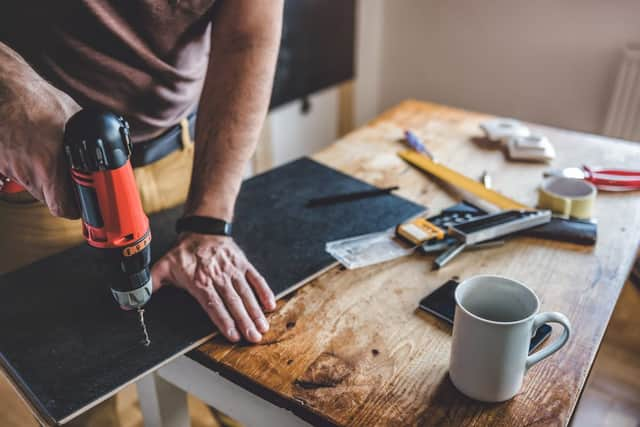Here are 6 easy DIY ideas for beginners - from resealing baths to painting rooms
This article contains affiliate links. We may earn a small commission on items purchased through this article, but that does not affect our editorial judgement.


DIY may seem daunting if you’re new to it, but creating, modifying and repairing things at home is not as tricky as it seems.
So if you have a few odd jobs to do around the house or would like to get stuck into a project, here are some ideas of easy DIY tasks you can do yourself.
Door fixes
Advertisement
Hide AdAdvertisement
Hide AdYour doors may begin to stick or fail to latch over time, or they may have become loose.
Screwing them back into place with a screwdriver can be an easy project to start, but you’ll also be working with a number of different carpentry skills.
One way of doing this is to remove the loose screw and dip the bare end of a wooden match into some carpenter’s glue and tap it with a hammer as far into the screw hole as it will go.
Break or cut off the match in line with the hinge plate and discard the heads.
Advertisement
Hide AdAdvertisement
Hide AdAfter you’ve filled the void in the screw hole with the wooden match, drive the screw into the hole with a screwdriver.
Continue to do this until you have fixed all loose screw holes.
This video shows you how to fix loose door screws quickly and easily.
You can buy a range of screwdrivers from Screwfix.
Fix cracks in windows and walls
Although cracks can start small, they can gradually get worse over time, especially if they’re around doors and windows.
Advertisement
Hide AdAdvertisement
Hide AdYou can easily fill them in with a substance called caulk, making sure you smooth off any excess with a knife or razor blade.
If you’ve got a really big hole in the wall, you can fill it with newspaper before adding caulk, as the newspaper gives the filler something to hold on to.
Caulk is available to buy at Toolstation.
Reseal your bath
Replacing sealant is easier than you think, however, you’ll need to purchase a sealant gun, such as this one from Screwfix from £4.99.
Use a Stanley knife to remove the old sealant by slicing through the top and bottom edges at one end before pulling the sealant from the wall.
Advertisement
Hide AdAdvertisement
Hide AdAlthough it should come out easily, make sure to scrape off any excess with a scraper or scrub pad.
Then, fill your bath before resealing so that the gaps between bath and tile are at their largest, and then with the sealant gun, fill the gap in one smooth, consistent motion. Leave it to dry for a day.
This video shows you how to seal your bath.
Painting
Painting a room is a go-to DIY task for beginners.
You could be touching up a patch, painting a whole wall or giving a fresh lick of paint to the skirting boards.
Before you begin painting, you will need to make sure your walls are prepped for the job so examine the surface of the wall for flaking paint, bumps and holes.
Advertisement
Hide AdAdvertisement
Hide AdUse filler for any cracks and holes - let it dry, sand down the surface and seal with sealant. For flaking paint and bumps use a scraper to even the surface before sanding and sealing.
Cover your room with old sheets so that you don’t ruin any flooring with paint splatterings.
For more detailed instructions on how to prepare your room for painting, watch this video from Wickes.
You can purchase paint, brushes and other painting equipment from B&Q.
Fix a blocked drain
Advertisement
Hide AdAdvertisement
Hide AdFixing a blocked drain is easier than you might think, and if you do it regularly you’ll have healthier drains.
If you happen to have any bicarbonate of soda and vinegar in your kitchen, these make for excellent drain cleaners, and are widely available in supermarkets.
Simply pour bicarbonate down the blocked drain and then flush through with the vinegar.
However, if there’s still problems, you can use an old-metal coat-hanger to try and get out any hair blockages.
If your sink is blocked, this video could help.
Sort draughts out
Advertisement
Hide AdAdvertisement
Hide AdIf you’ve got an annoying draught, you can easily make your own draught excluder.
You will need a piece of fabric that’s longer than the width of your door. Start by rolling it into a tube and blocking off one end, then fill it with any old clothing you can find.
For this you can use tights and socks, or if you don’t have any of these you can always use sand or lentils.